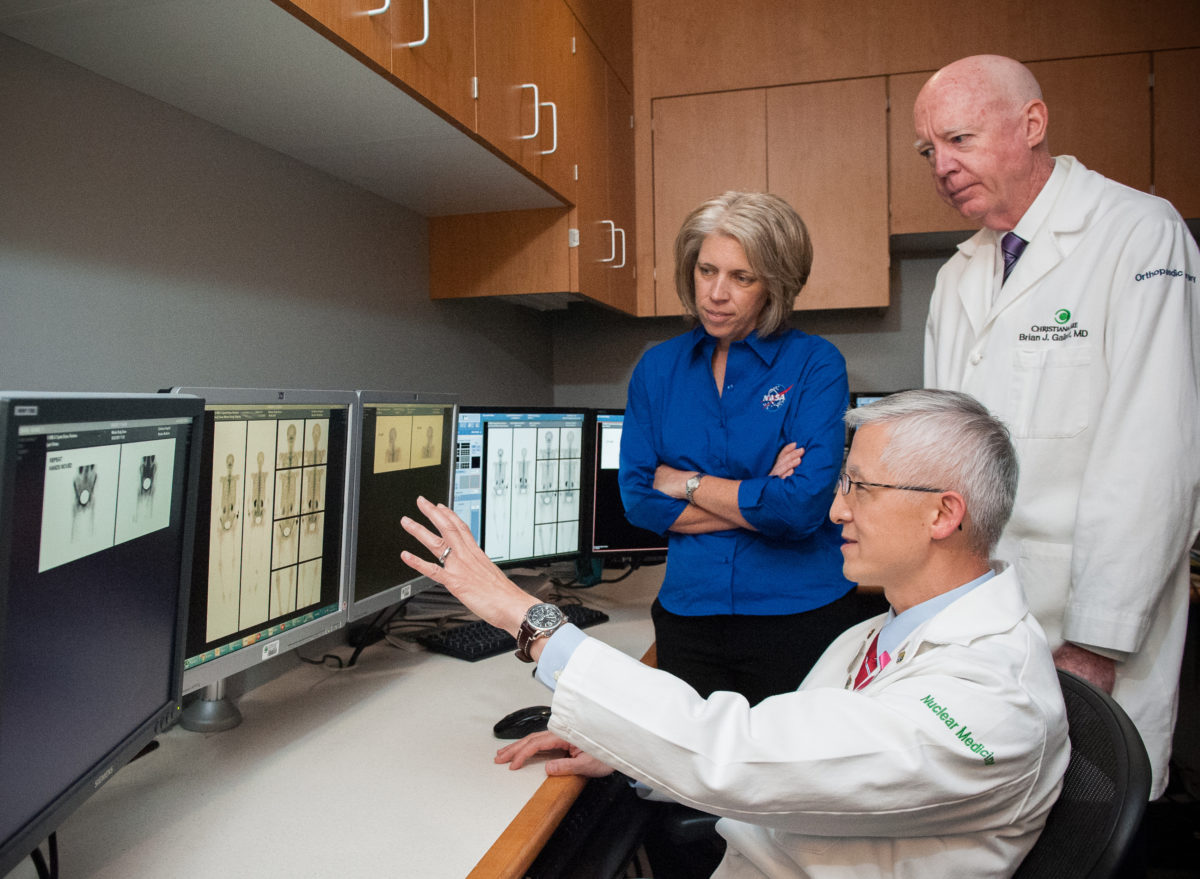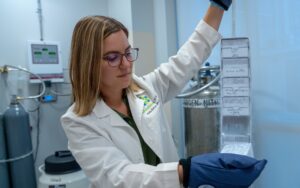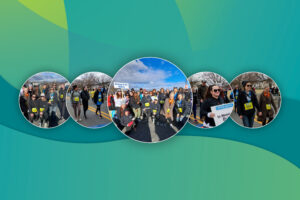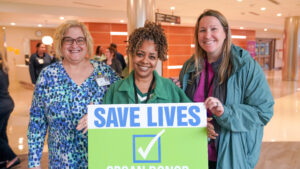Attendees of the 10th Annual Orthopaedic Symposium, Oct. 28 at Christiana Care, learned about research opportunities on the International Space Station, where there are 200 experiments in progress at any given time.
Tara Melaine Ruttley, Ph.D., associate program scientist for the International Space Station at NASA’s Johnson Space Center in Houston, was a special guest speaker for the event, and she encouraged symposium attendees to consider the space station national laboratory for their research.
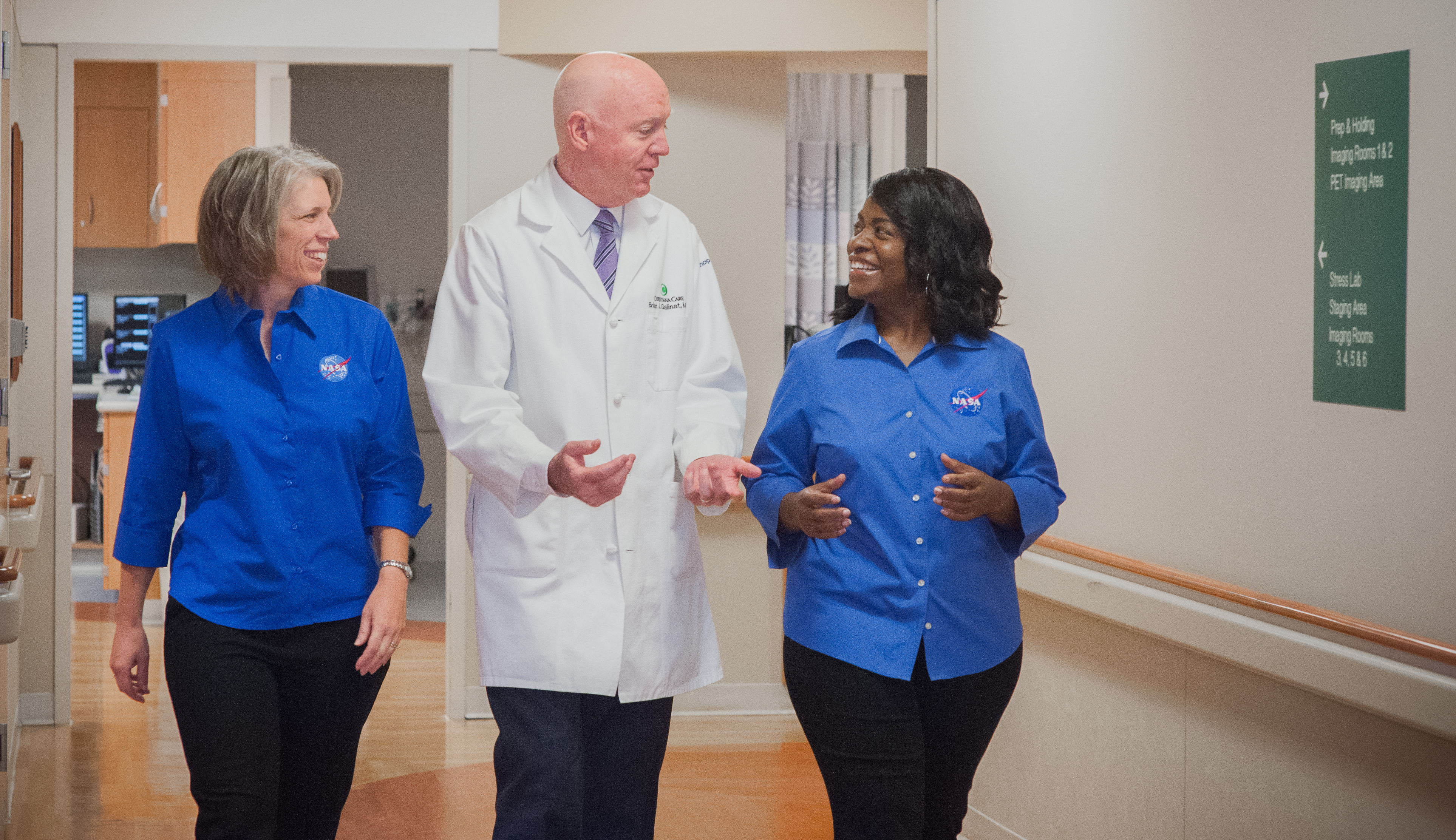
Dr. Ruttley also toured Christiana Hospital with Brian J. Galinat, M.D., MBA, chair of Christiana Care’s Department of Orthopaedic Surgery and physician leader of the Musculoskeletal Service Line, and learned about the Strong Bones and Safe Steps programs.
According to the 2018 Hospital Quality Rankings by CareChex, a nationally-recognized medical quality rating service, Christiana Care is ranked the No. 3 hospital in the nation for major orthopaedic surgery; the No. 6 hospital in the nation for spinal fusion; the No. 7 hospital in the nation for spinal surgery; and the No. 10 hospital in the nation for joint replacement care. Christiana Care also is ranked by CareChex as the No. 1 hospital in the Philadelphia metropolitan area for major orthopaedic surgery, spinal fusion and spinal surgery. In addition, Christiana Care is ranked as a high-performing hospital in orthopaedics by U.S. News & World Report and has been named by Becker’s Hospital Review as one of “100 Hospitals and Health Systems with Great Orthopaedic Programs.” This recognition comes on the heels of Christiana Care’s recent ranking by Becker’s as one of the “Best Hospitals for Joint Replacements in all 50 States.”
Dr. Galinat and Dr. Ruttley took part in a wide-ranging discussion that included how research within the space station is helping doctors and scientists to better understand orthopaedics here on Earth.
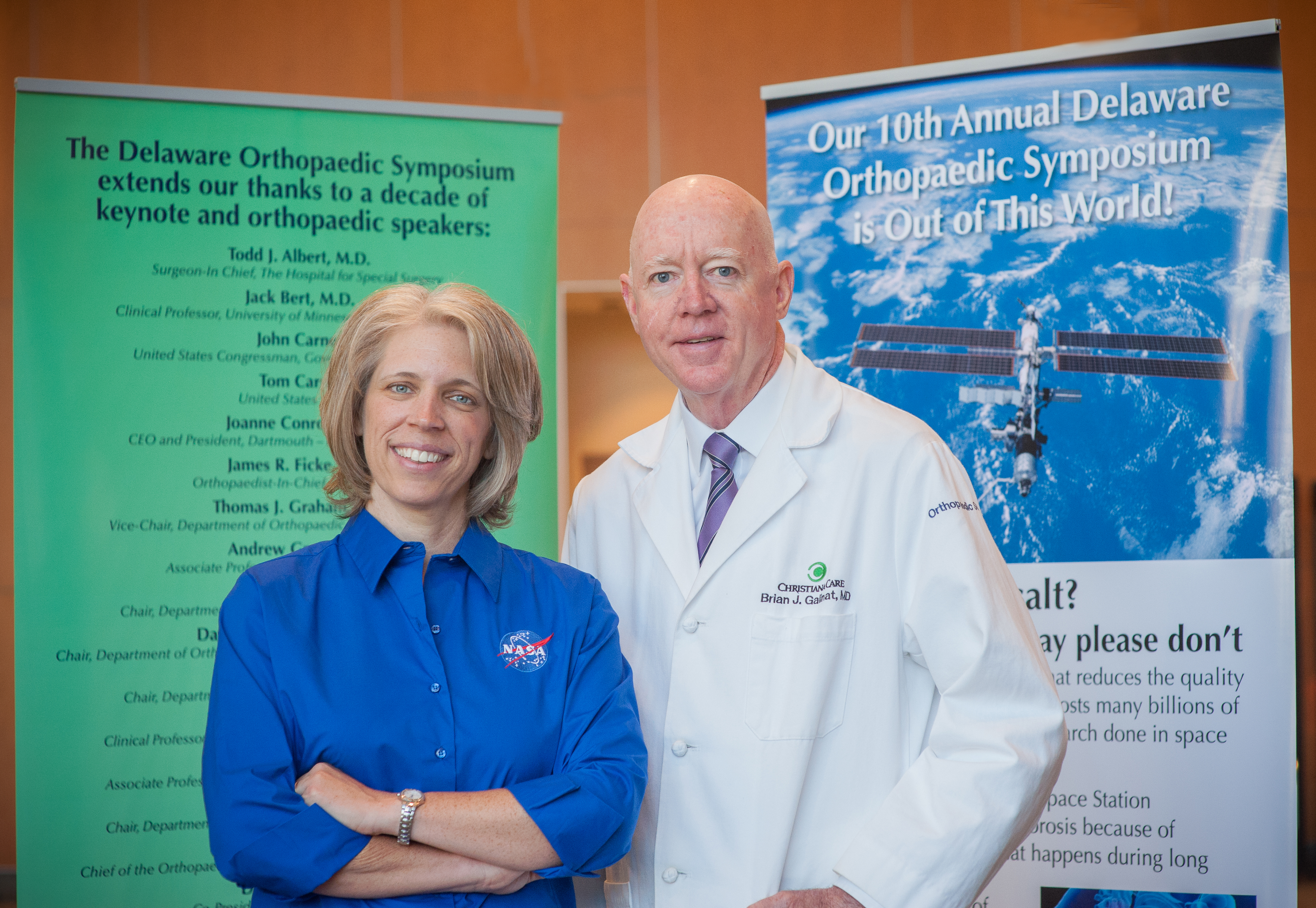
In this Q&A, Dr. Ruttley and Dr. Galinat share their expertise and some of what they learned from each other during the visit.
Q: Dr. Ruttley, what is your message to Delaware Orthopaedics Symposium attendees?
TR: I want to inspire them to consider using the space station as a platform for their research and to share some of our significant findings. As a U.S. National Laboratory, the space station is open to other government agencies, universities, private institutes, commercial entities and individual researchers with good ideas. Perhaps if symposium attendees don’t use the space station laboratory, they can use what we have learned and apply it here in Delaware.
Q: What makes the environment of space valuable for research?
TR: What’s unique about using the space environment is microgravity. In an earth laboratory there are lots of variables you can control, such as temperature, pressure and lighting. But you can’t control the major force of gravity, and that will factor into all physical behavior. I tell researchers that if there is an area where you are stuck in your research, you may want to consider the microgravity of space.
Q: What has NASA learned about bone loss among astronauts in space?
TR: It’s similar to what you hear in osteopenia consultations on earth. We know our astronauts are accelerated models of aging. We are designed with our bones and muscles because of gravity. When you take the gravity away, you start to see atrophy in the muscles. In space, astronauts tend to lose bone in the weight-bearing areas at the rate of 2 percent a month, a rate equivalent to the bone loss of a post-menopausal woman.
Q; How does NASA approach the potential for bone loss during extended space exploration?
TR: We designed a machine called the Advanced Resistive Exercise Device that provides astronauts the opportunity to do weight-bearing exercise. We also research pharmaceuticals and study the body’s natural systems, along with many aspects of nutrition. Overall, we’ve seen we can maintain bone health in space with the right resistive exercise, with astronauts eating all their calories, and by them consuming an increased dose of Vitamin D. That is a wonderful breakthrough, because we want healthy bones when astronauts travel to Mars.
Q: What are the implications for people here on Earth?
TR: Osteoporosis in the elderly is similar to what’s observed in astronauts when nothing is done to compensate for the space environment. We also see changes in T-cell health and the immune system. Elements such as balance and walking are affected as well. This is because in space there is no up or down. The visual component of reference is taken away. In my research, we’ve seen that microgravity changes gait patterns and can lead to an increased risk of falling and bone fracture back on earth.
Because of space research, there have been advances in telemedicine, disease models, psychological stress response systems, nutrition, cell behavior and environmental health.
Q: What’s been rewarding for you personally in your role as a research scientist?
TR: It’s the relationships I form. I am a program scientist, and I get to meet all the potential researchers. It is exciting to meet people who prior to meeting with us had never thought space was accessible for research, and watch them begin to sketch out new ideas. We are living in the golden age for this type of research.
Q: What stands out to you about your visit to Christiana Care?
TR: One of the more interesting things that stood out to me was the interdisciplinary nature of Christiana’s Strong Bones and Safe Steps programs. In much the same way NASA tackles musculoskeletal health in our astronauts, Christiana Care’s approach to prevention uses a range of different experts to evaluate a particular individual’s needs. The overlaps between the programs have opened up some interesting discussions of potential opportunities for collaboration in areas that could benefit both NASA and Christiana Care.
Q: Dr. Galinat, where do you see a connection between NASA’s research and what Christiana Care is doing?
BG: The connection is to reach for a better future, to use research and discover knowledge that keeps people healthy and active.
Bone health is the cornerstone of our Musculoskeletal Service Line. Our Strong Bones effort has helped more people gain an understanding of their bone health and how to receive proper treatment. For instance, there is a quick evaluation called a Bone Density Test that helps identify people at risk for bone fracture. Unfortunately, sometimes we learn about poor bone health after a fracture. But there are still opportunities for our bone health program to help a patient heal a fracture and prevent the next one. To prevent fractures there are innovative programs at Christiana Care, such as the Safe Steps and Strong Bones programs.
Using a multidisciplinary approach, the Safe Steps and Strong Bones programs coordinate care with primary care physicians. For instance, Safe Steps involves an evaluation by physicians, physical therapists and a nurse navigator. A first goal is to educate people on how they can decrease their risk of falling and might include ridding the kitchen of throw rugs, which can trigger a fall. While we do excellent work fixing things, we would rather bones not get broken. With Strong Bones, a patient can be referred pre-operatively or after a surgical repair. Prior to surgery, it’s important for patients to understand their Vitamin D level, their bone density and their calcium intake for a better outcome.
Our model is much like that of the Helen F. Graham Cancer Center & Research Institute, where different specialists come together so a patient doesn’t need separate visits. We know primary care physicians address many needs, and bone health can fall down the list of what is discussed. And that’s why this is a silent disease. So, with our Strong Bones program, we go beyond the primary care physician so patients can talk with a geriatrician, a rheumatologist, as well as specialists in physical medicine and rehabilitation. Better communication leads to better coordinated care and better health.
Q: What advice do you have for people who want to practice optimal bone health?
BG: News flash — there is no news. It’s what Dr. Ruttley suggested: better diet and exercise. People can help themselves through weight-bearing exercise, proper dietary calcium and Vitamin D, if a supplement is needed. That takes care of the vast majority of people. Beyond those basics, we hope the research being done on the International Space Station will give us more options to help people who need additional treatments.
Q: Where is the leading edge of interest in the practice of orthopaedic medicine?
BG: Christiana Care is leading the region in surgical pain management techniques that allow for the limited use of opioids after surgery. In some cases no opioids are used. Now imagine a joint replacement procedure and taking no narcotics. We have been able to do that with some patients.
Q: Tell us about the Center for Advanced Joint Replacement. What makes that unique?
BG: Our comprehensive program is nationally recognized, and the special sauce is our partnership with community surgeons. Each year, we do about 3,000 spine surgeries and 3,000 hip- and knee-replacement surgeries. We have collaborated with the hospital’s Department of Quality and Patient Safety to decrease the length of stay of joint patients, and decrease the percentage of patients going to skilled nursing facilities. We not only focus on quality, but we also focus on making care affordable by delivering surgeries at lower costs. We have decreased the internal costs associated with joint replacement surgery by 17 percent in last two years. Now we have an opportunity to forge a new partnership with NASA that will help us even further improve orthopaedic care for our neighbors throughout Delaware and its surrounding areas.
